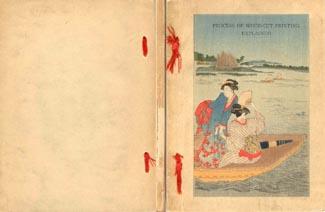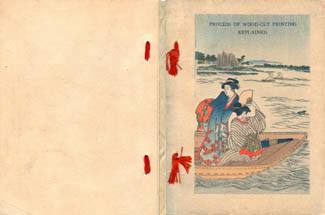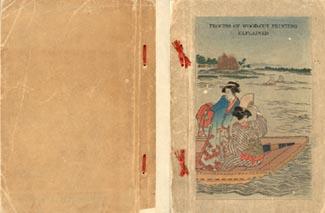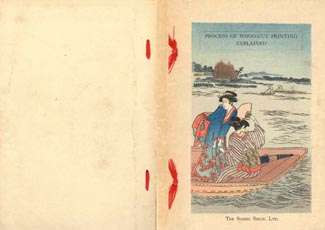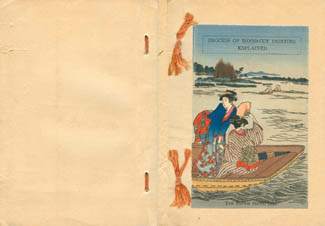The Shimbi Shoin, Ltd.:
Process of Wood-Cut Printing Explained, Tokyo, Shimbi Shoin, Ltd, c1916 ~ 1938, 16mo (5 x 6 1/2 in) ribbon stab ties, stiff wraps with a color woodcut on the front cover, 44 pp (4 page introduction and 40 pages of woodcuts). The woodcut pages are printed on single sheets and then joined along the outside edge with glue. A step by step illustrated guide to how color woodcut prints are made. Using a single print ("Two Beauties in a Boat" by Kiyonaga) as the basis for the guide, as you go through the book a color woodblock (woodcut) print progresses through the various manufacturing stages to become a completed image. Each color (even shades of the same color) requires a different block and this is demonstrated step by step. The book contains a 4 page (actually 2 folded pages) introduction and the balance consists of 20 woodcuts (one for each color) on the left page and the resulting cumulative state of the woodblock print on the right page. The introduction is printed on thinner paper than the pages with the actual woodblock illustrations. The woodcuts are printed on high quality tannish hosho paper. The final woodblock print in the book is the print in it's completed state and the completed print is also on the front cover.
I have observed four minor variations of this book.
- Type I. This variety has the date March 10, 1916 just before "Shimbi Shoin" at the conclusion of the introduction. While all the books have the same length and width dimensions, the one bearing the 1916 date is thinner measuring .7 cm across the spine. The c1916 book has a spine covered with very thin paper which generally is partially or totally missing.
- Type IIa. This variety has the date January 10, 1920 just after "Shimbi Shoin" at the conclusion of the introduction.. It is thicker than Type I, measuring 1 cm across the spine. It has a thicker paper cover over the spine and it is generally present. The book measures 5 x 6 3/4 in.
- Type IIb. This variety does not have a date. It is thicker, measuring 1.2 cm across the spine. It has a much thicker paper cover over the spine and it is generally present. I date this book at c1920. But that is not based on a positive dating.
- Type IIIa. A book very similar to the Type IIb book, above, but with an additional two pages in Japanese following the four page English introduction. This makes 46 pages total. This book measures 4 3/4 x 6 7/8 in (12.2 x 17.6 cm) which is slightly taller but not as wide as the other versions. Like the Type II it is thicker measuring 1.2 cm across the spine. The title of this book is enclosed in a box and "The Shimbi Shoin, Ltd." is imprinted at the foot of the front cover. The various stages of the woodblock production depicted are almost, but not completely, the same as in the other books.
- Type IIIb. As the type IIIa book. However, "The Shimbi Shoin, Ltd." is imprinted at the bottom but within the woodblock on the cover. The Japanese language introduction follows the Englich introduction in this book. The book measures 5 x 7 1/8 in. On the page adjacent to the back cover, this book carries the Japanese year 2598 (1938).
I am aware of one other version of this book with the same title. It had a stated printing date of March 10th of Meiji 40 (1907). I have not examined that book so do not know if it is basically the same as those on this page.
The description of the woodcut process is contained in the first four pages of text. Here is how the process is described.
PROCESSES OF WOOD-CUT PRINTING EXPLAINED.
The art of wood-cut printing has been practised in Japan since the eighteenth century, but it made the first really tangible advance with the development of the Ukiyoe school of painters, and during the last few decades has been extensively applied for the reproduction of famous ancient masterpieces. The successive improvements introduced in this essentially Japanese art now place it beyond all possibility of outrivalry by artists of other countries.
The prints made by this process reproduce the slightest touch of the brush and the most delicate shades of colours in the originals, the result being such as can hardly be attained by lithographs. It can be truly said of Oriental paintings that except by this wood-cut process a faithful representation of the originals is impossible. The method of engraving and rubbing demands the utmost skill in the artizans, nor can the difficulties of the modus operandi be adequately measured by the casual observer of the printed picture. We propose, therefore, to give here a brief explanation of the process in the hope of making the real value of Japanese wood-cut printing more widely known.
The blocks are usually made from cherry-wood, but where very fine cutting is needed willow-wood is sometimes used. For each colour and for each shade of the same colour a separate block is provided, and for this reason the number of blocks used for a single picture often reaches several hundreds. A drawing of the ground lines is first made, with outlines of the colour scheme, and from this a block is cut. Having obtained the ground block, a new one for each colour is cut. Since the blocks are liable to swell or shrink with varying atmospheric conditions, it is very important to examine them carefully before going to press, and dry or moisten them as the case may demand. This part of the process requires a great amount of skill in the artizan. Several blocks are sometimes required to print one colour, as it is not always possible to print a whole mass of colour in one shade and at the same time, but a series of blocks has to be employed to produce the desired effect. Laying a single colour on the block in the right manner itself constitutes a difficulty. The usual process of printing begins with the lightest colour and proceeds on to thickest ones, and it varies according to the nature of the colours used in the originals. The rapidity with which colours, sometimes single and sometimes double, dry, must also be taken into consideration, for it is one of the conditions that decide the order or succession of prints. The delicate shading is done with a brush. After the colour has been laid on the block with a brush, the paper is rubbed from the back with an instrument called "baren," made of a piece of ropework covered with a bamboo sheath, which is slightly moistened with oil to make it soft and smooth. A specimen copy of the finished picture is kept before him by the artizan, who is extremely careful to make each copy follow the sample picture in every detail. Only water colours were used till a few years ago, but it has recently been found possible to employ even white lead. Further we have made experiments that have resulted in our being enabled to use vedigris and Prussian blue, and there is now hardly any pigment that cannot be successfully employed in our wood-cut printing.
Every variety of our pictorial art productions can be reproduced by our method of wood-cut printing, which has made a signal developement within the past few decades. The shades produced on our prints are precisely the same as in the originals in tone and materials used, the latter including gold and silver dust, Prussian blue, and verdigris. As a matter of fact our method of reproduction increases the difficulties of the work, but we point with pride to the result, the original pictures reproduced without the slightest deviation in technique or colouring.
The Shimbi Shoin, Ltd.,
Tokyo.
(The Process of Wood-cut Printing Explained, published by the Shimbi Shoin, ca 1920, pages 1-4.)
Wood-Cut Plates (Type I Book)
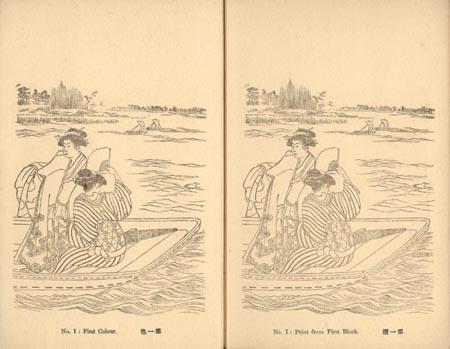
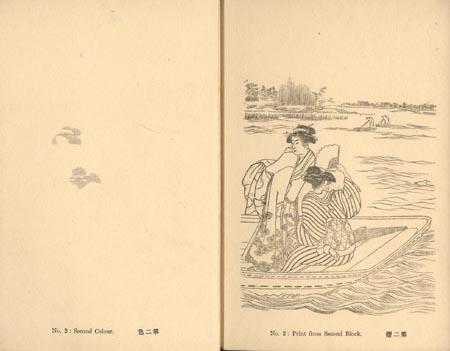
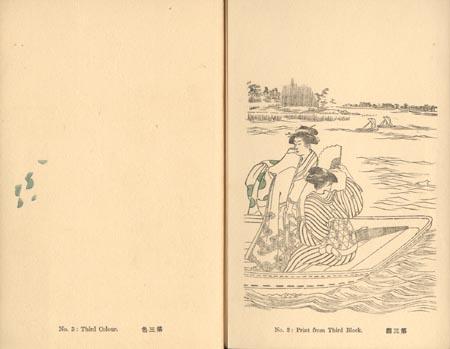
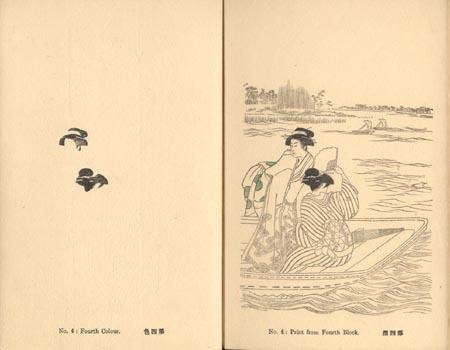
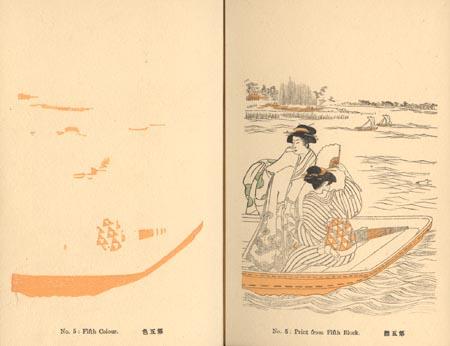
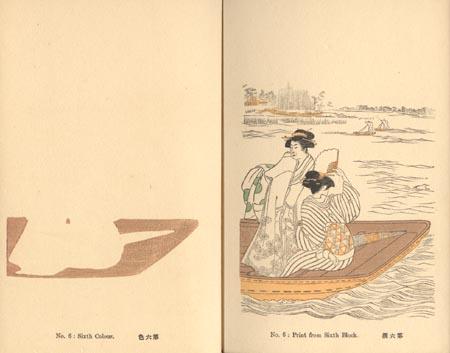
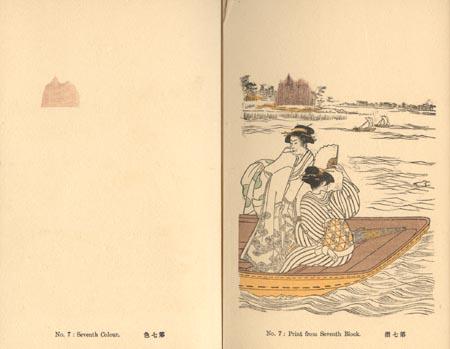
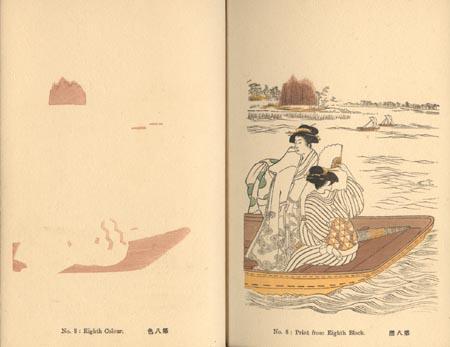
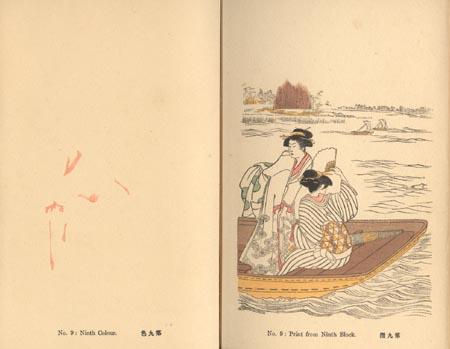
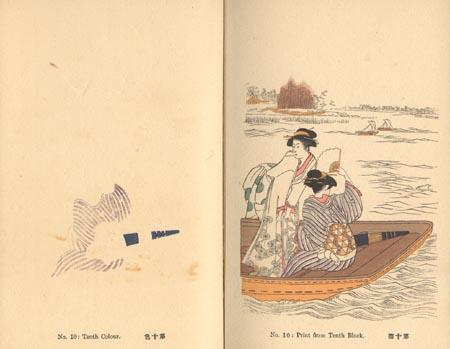
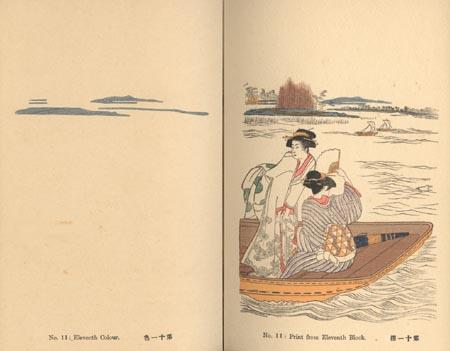
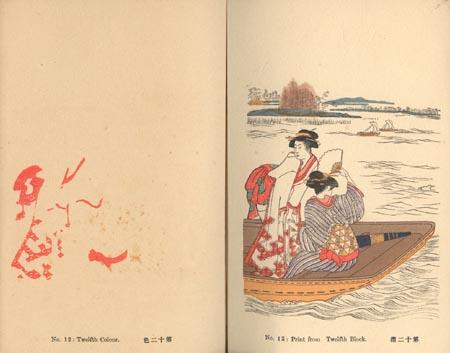
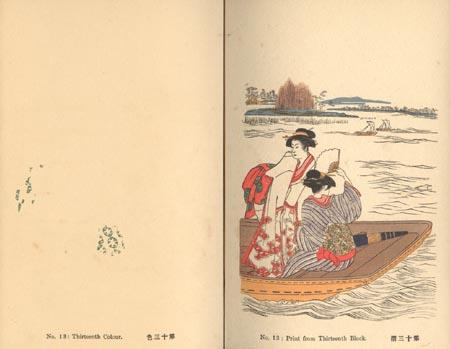
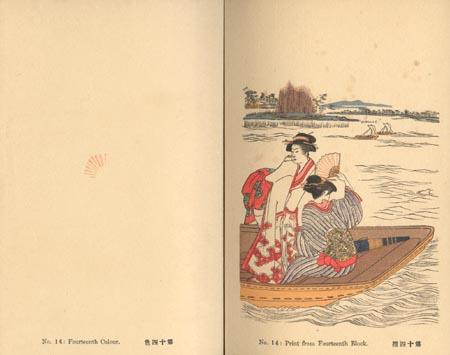
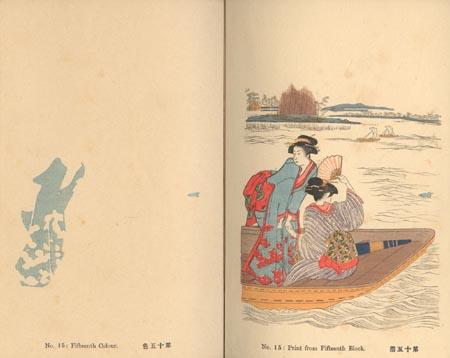
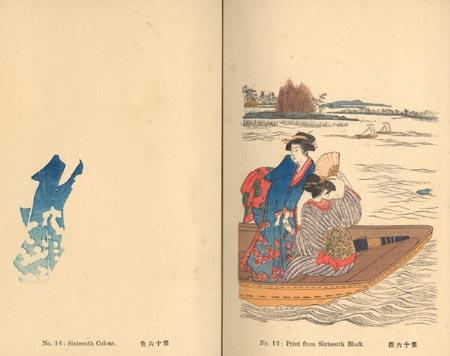
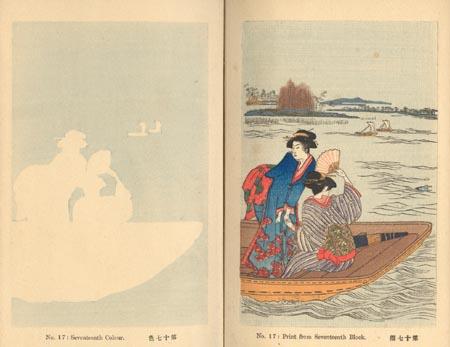
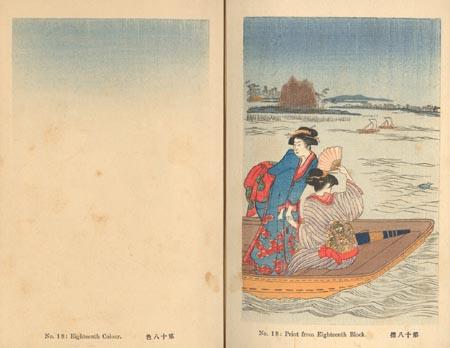
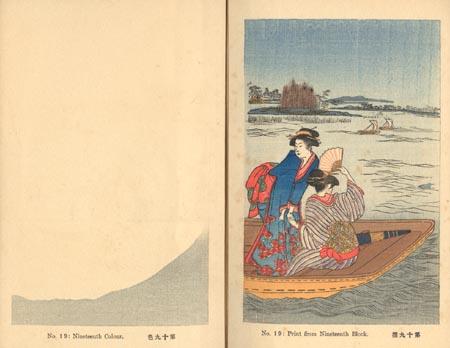
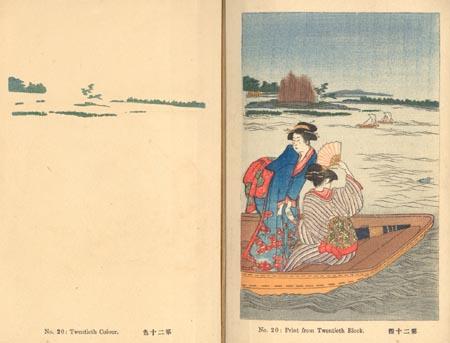
No Colophon
Type IIIb - Printing Info on Page Following Last Woodcut

Top Line: Tokyo Address
Second Line: Shimbi Shoin
2598 Year (1938)
For more information on Shimbi Shoin and books published by that firm, click here.
Books/Folios With Actual Color Woodblock Prints Illustrating the Process of Color Woodblock Printing:
- 1907, Process of Wood-Cut Printing, The Shimbi Shoin, Tokyo, 127 pairs of prints.
- 1907, Process of Wood-Cut Printing Explained, The Shimbi Shoin, Tokyo
- c1916-1938, Process of Wood-Cut Printing Explained, (Two Ladies in a Boat), The Shimbi Shoin, Tokyo, more information here.
- c1920, Process of Wood-Cut Printing Explained (Lady Fishing), The Shimbi Shoin, Tokyo, more information here.
- 1932, Multi-Coloured WoodBlocks (Beauty Playing with a Cat), The Shimbi Shoin, Tokyo, more information here (30 color blocks).
- c1938, The Process of Wood-Cut Printing, Asaksa Temple, Doi Hangaten, Tokyo, more information here.
- c1940, Process of Wood-block Printing, Nishinomiya & Hasegawa, Inc, Tokyo, more information here.
- c1950, The Process of Wood-block Color Printing (Woman in Snow with Umbrella), Takamizawa Mokubansha., Tokyo, more information here.
- c1950, The Process of Wood-block Color Printing (Young Lovers Walking Together under an Umbrella), Takamizawa Mokubansha., Tokyo, more information here.
- c1950, Japanese Woodblock Prints, Uchida Wood Block Printing Co. Ltd, Kyoto, more information here.
- c1950, The Process of Color-Block Printing (Fuji and Trees), S. Watanabe, Tokyo (Ginza), more information here.
- c1950, The Process of Color-Block Printing (Fuji and Wave), S. Watanabe, Tokyo (Ginza), more information here.
- c1953, Process of Wood-block Printing (Fuji and Wave), probably Nishinomiya/Hasegawa, Tokyo, more information here.
- c1953, Process of Wood-block Printing (Winter Scene with Temple & Lantern), probably Nishinomiya/Hasegawa, Tokyo, more information here.
- c1956, Process of Printing Wood Engraving, Unso-do Co., Kyoto, Harunobu, woman beating cloth, more information here.
- c1956, Process of Wood Cut Printing, Unso-do Co., Kyoto, Utamaro, two women doing handcrafts from "One of Twelve Sketches of Handicraft Arts for Women," more information here.
- c1956, Process of Printing Wood Engraving, Unso-do Co., Kyoto, Utamaro, two women cooking from "One of Twelve Sketches of Handicraft Arts for Women," more information here.
- c1956, Process of Printing Wood Engraving, Unso-do Co., Kyoto, Utamaro, two women weaving cloth from "One of Twelve Sketches of Handicraft Arts for Women," more information here.
- c1956, Process of Printing Wood Engraving, Unso-do Co., Kyoto, Utamaro, "Waitress Okita from the Naniwaya Tearoom," more information here.
- c1956, The Japanese Wood-Print, Unso-do Co., Kyoto, pamphlet discussing history of the Japanese wood-print and the implements/methods of manufacture, more information here.
- c1963 The Process of Wood-block Color Printing, (Hiroshige's "Night Scene at Kambara"), H. Nakazawa, Tokyo, more information here.
- c1970, Process Book of Woodblock Printing (Walking in Snow), Uchida Uchida Art Co., Ltd., more information here.
- c1970, Process Book of Woodblock Printing (Two Children Playing), Uchida Uchida Art Co., Ltd., more information here.
Woodblock Print Books Available for Purchase (Process Books):
- 1940, Multi-Coloured WoodBlocks, , Process of Wood-block Printing, Nishinomiya & Hasegawa, Inc, Tokyo, purchase here.
- 1932, Multi-Coloured WoodBlocks, (Beauty Playing with a Cat), The Shimbi Shoin, purchase here.
- 1938, Process of Wood-Cut Printing Explained, (Two Ladies in a Boat), The Shimbi Shoin, purchase here.
- c1956, Process of Printing Wood Cut Printing, Unso-do, Kyoto, Utamaro, two women doing handicrafts - "One of Twelve Sketches of Handicraft Arts for Women, purchase here.
- c1956, Process of Printing Wood Engraving, Unso-do, Kyoto, Two Women Cooking from "One of Twelve Sketches of Handicraft Arts for Women," purchase here.
- c1970, Process Book of Woodblock Printing, Walking in the Snow, Uchida Uchida Art Co., Ltd., reddish brown boards, purchase here.
Miscellaneous Woodblock Print Books and Folios Available for Purchase (Other than Process Books):
- c1960, The Tokaido Fifty Three Stations by Hiroshige, Unso-do, Kyoto, purchase here.
- c1960, The Thirty Six Views of Mount Fuji by Hokusai, Unso-do, Kyoto, purchase here (Fine/Fine).
- c1960, The Thirty Six Views of Mount Fuji by Hokusai, Unso-do, Kyoto, purchase here (Fine/Very Good).
- c1960, Twelve Months of Kyoto, (folio of 12 woodblock prints), Uchida Wood Block Printing Co., Ltd, Kyoto, Tokuriki Tomikichiro, purchase here.
- c1960, Four Seasons of Tokyo, (folio of 4 woodblock prints with presentation folder) Uchida Wood Block Printing Co., Ltd, Kyoto, Tokuriki Tomikichiro, purchase here.
- c1960, Four Seasons of Tokyo, (folio of 4 woodblock prints without presentation folder) Uchida Wood Block Printing Co., Ltd, Kyoto, Tokuriki Tomikichiro, purchase here.
|
